Abstract
BACKGROUND--High neural drive to the respiratory muscles and rapid and shallow breathing are frequently observed in patients with chronic obstructive pulmonary disease (COPD), and both mechanical and chemical factors are thought to play a part. However, the interrelation between these factors and the modifications in the control of breathing are not clearly defined. The effects of an acute decrease in mechanical load by the administration of a high dose of a beta 2 agonist were studied. METHODS--Nine spontaneously breathing patients with severe COPD took part in the study. Criteria for entry were FEV1 of < 40% of predicted and an improvement in FEV1 of < 200 ml after inhalation of 400 micrograms fenoterol. The following parameters were measured: lung volumes, tidal volume (VT), respiratory frequency (Rf), maximal pleural pressure during a sniff manoeuvre (PPLmax), pleural pressure swings (PPLsw), lung resistance (RL), RL/PPLmax ratio, and surface electromyographic activity (EMG) of diaphragm (EDI) and parasternal (EPS) muscles. Arterial oxygen saturation (SaO2), end tidal carbon dioxide pressure (PETCO2), and the electrocardiogram were also monitored. Each variable was measured under control conditions and 20 and 40 minutes after the inhalation of 800 micrograms fenoterol. In five patients the effects of placebo were also studied. RESULTS--Fenoterol resulted in an increase in FEV1 and decrease in FRC. SaO2 did not change, while PETCO2 fell and heart rate increased. The VT increased, and Rf decreased, PPLsw fell and PPLmax increased, thus the PPLsw/PPLmax ratio fell. Both RL and RL/PPLmax also fell, and a substantial decrease in EDI and EPS was observed. Changes in PPLsw were related to changes in FEV1 and RL. Changes in VT and Rf, and EDI/TI and EPS/TI were also related to changes in PPLsw and RL/PPLmax ratio, but not to changes in FEV1. No variation was observed with placebo. CONCLUSIONS--In patients with severe COPD a decrease in inspiratory muscle loading relative to the maximal available strength, as expressed by the RL/PPLmax and PPLsw/PPLmax ratios, appears to be the major determinant of changes in breathing pattern and inspiratory muscle activity (decrease in EMG).
Full text
PDF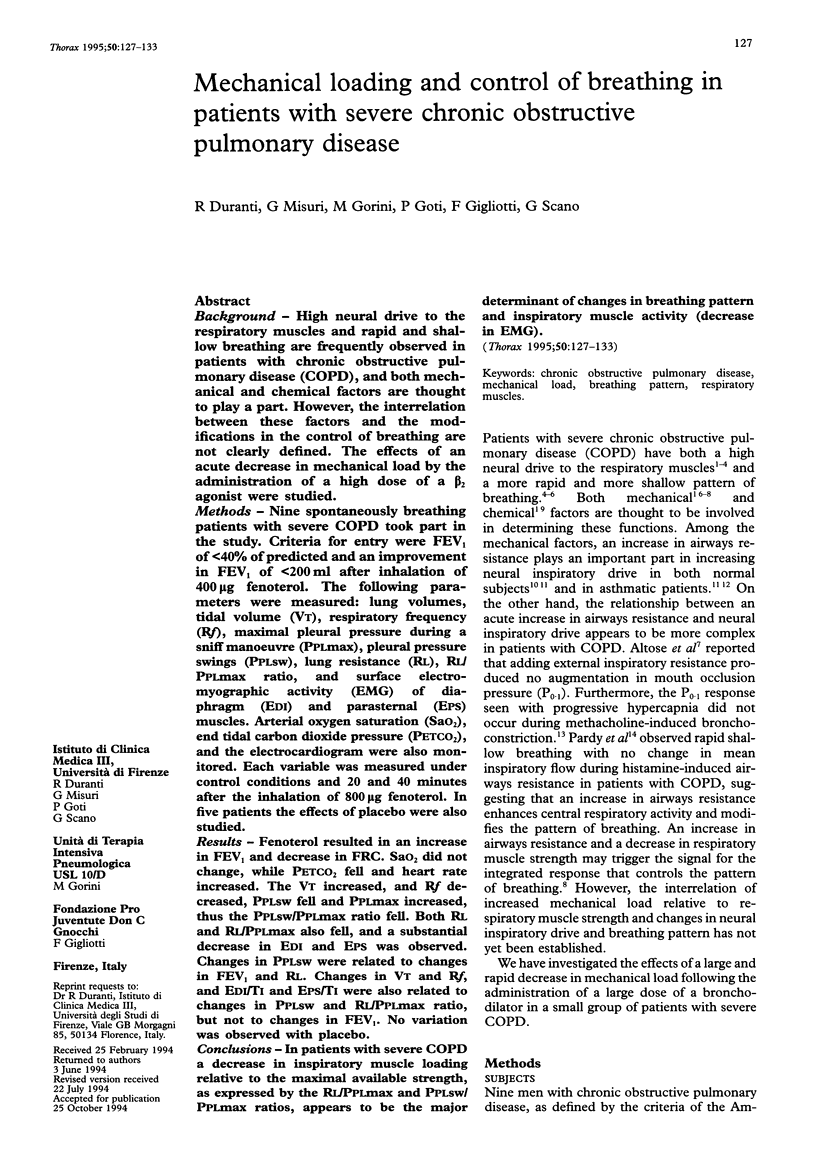
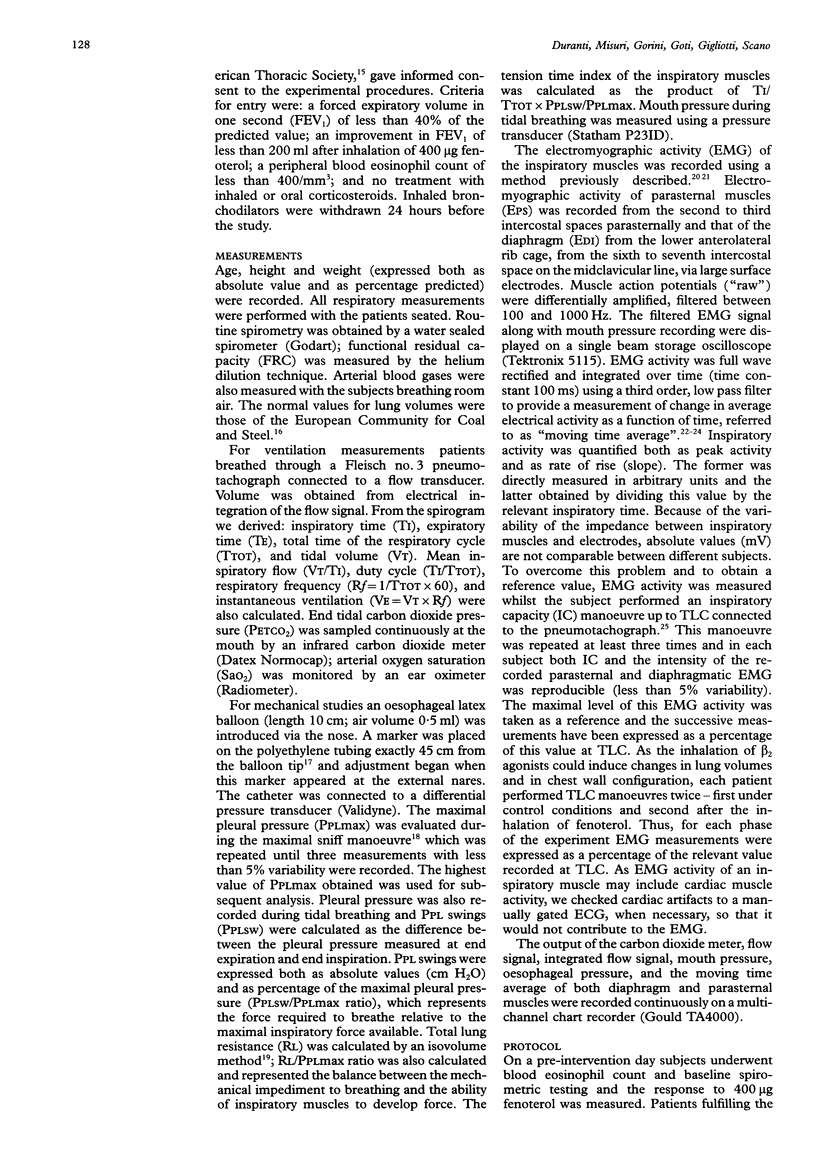
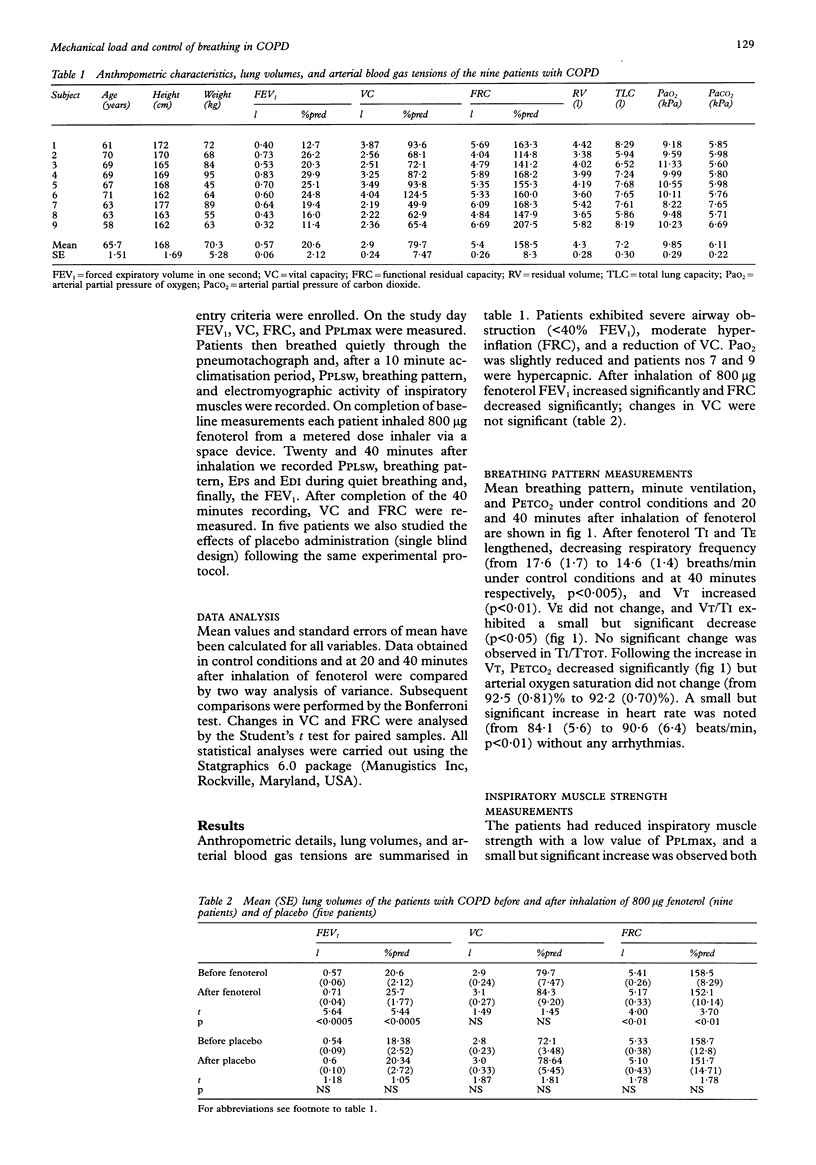
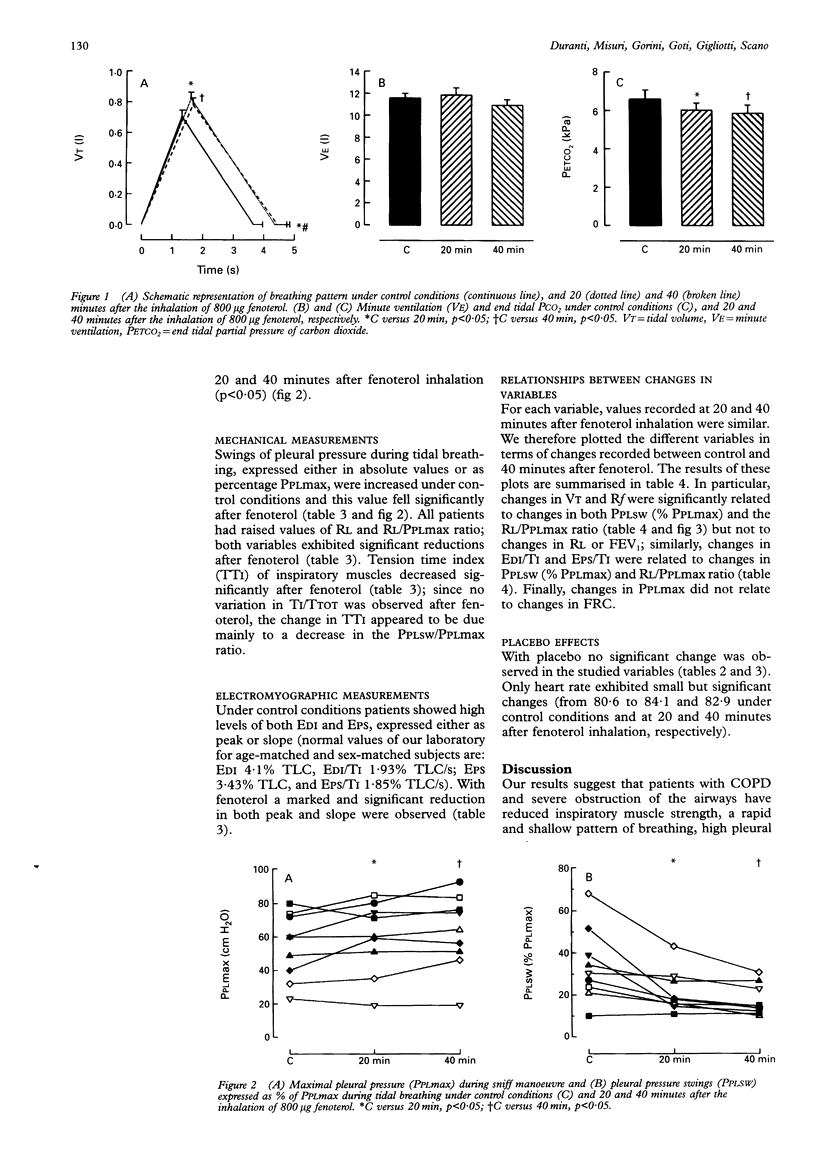
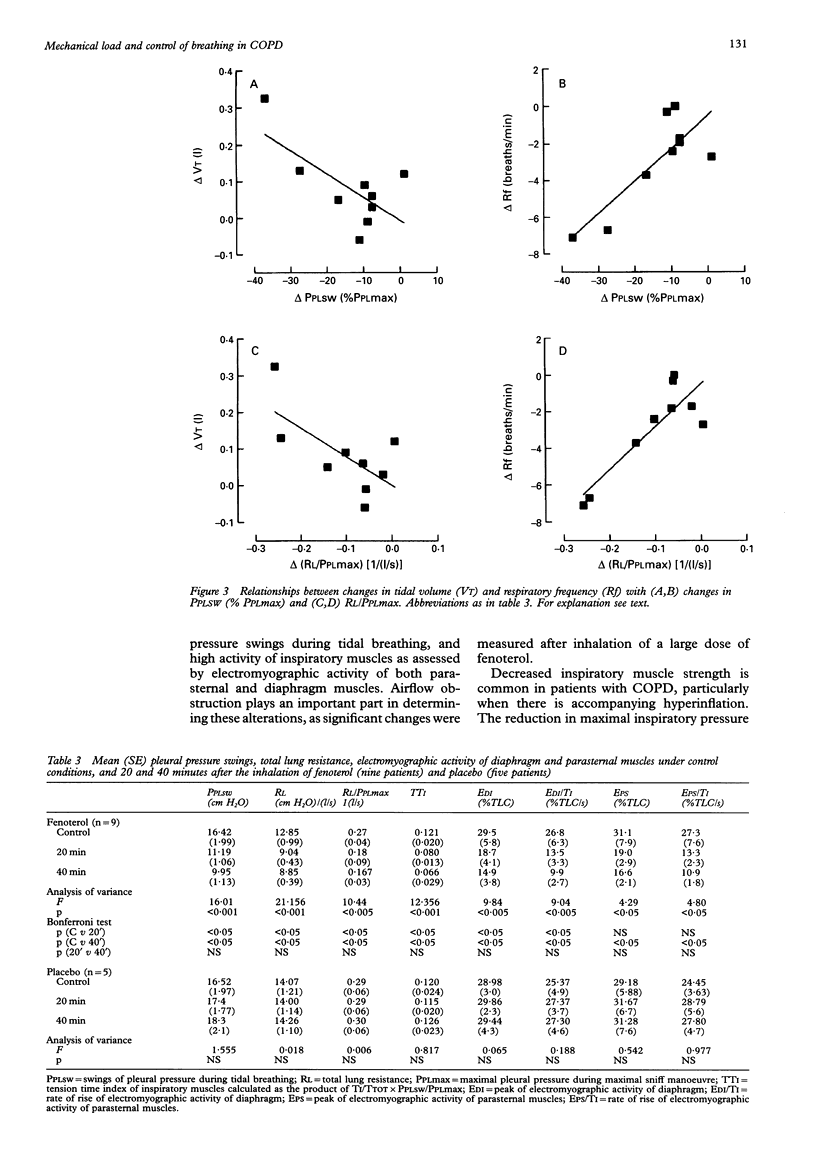
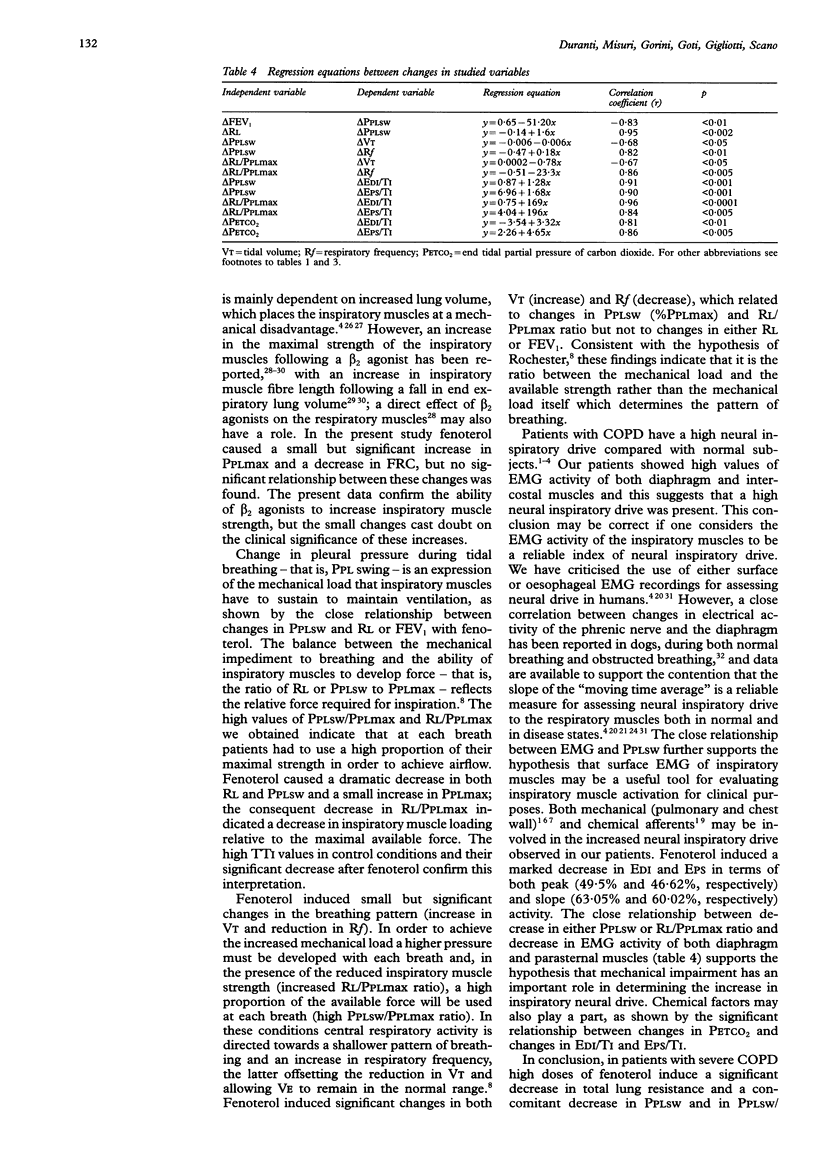
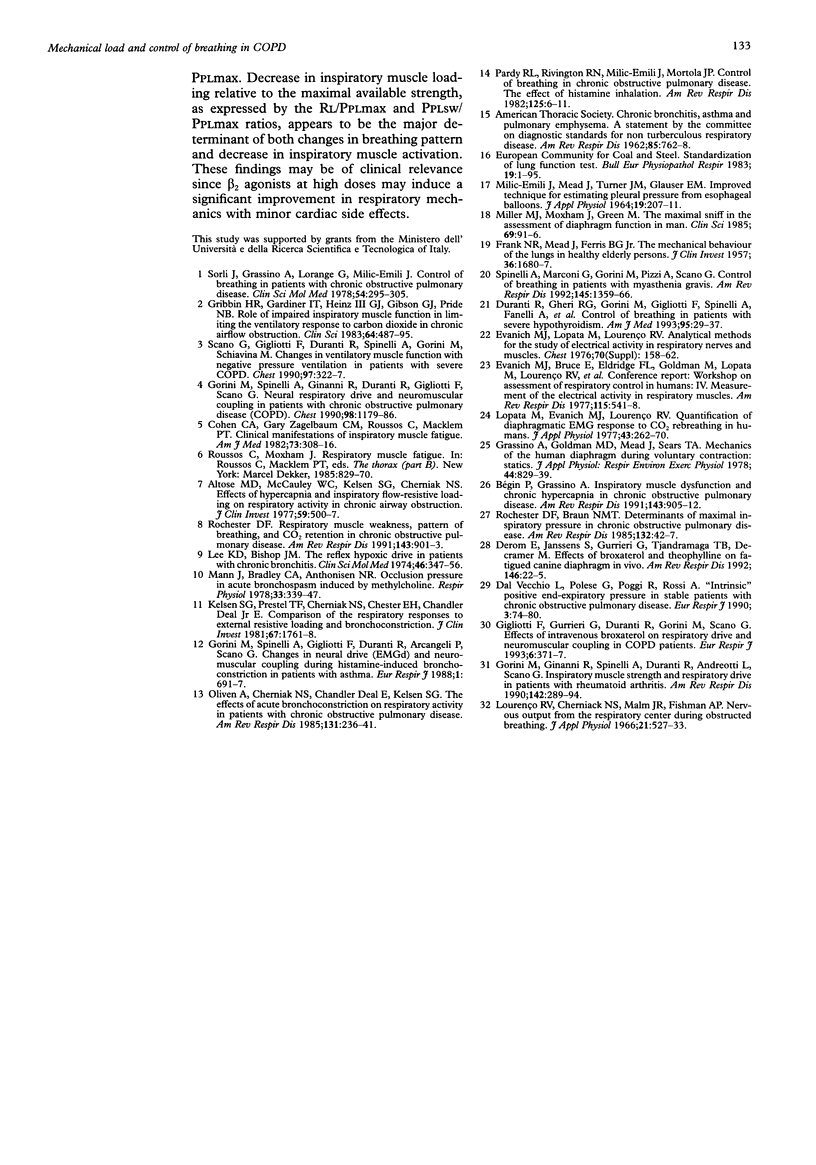
Selected References
These references are in PubMed. This may not be the complete list of references from this article.
- Altose M. D., McCauley W. C., Kelsen S. G., Cherniack N. S. Effects of hypercapnia and inspiratory flow-resistive loading on respiratory activity in chronic airways obstruction. J Clin Invest. 1977 Mar;59(3):500–507. doi: 10.1172/JCI108665. [DOI] [PMC free article] [PubMed] [Google Scholar]
- Bégin P., Grassino A. Inspiratory muscle dysfunction and chronic hypercapnia in chronic obstructive pulmonary disease. Am Rev Respir Dis. 1991 May;143(5 Pt 1):905–912. doi: 10.1164/ajrccm/143.5_Pt_1.905. [DOI] [PubMed] [Google Scholar]
- Cohen C. A., Zagelbaum G., Gross D., Roussos C., Macklem P. T. Clinical manifestations of inspiratory muscle fatigue. Am J Med. 1982 Sep;73(3):308–316. [PubMed] [Google Scholar]
- Dal Vecchio L., Polese G., Poggi R., Rossi A. "Intrinsic" positive end-expiratory pressure in stable patients with chronic obstructive pulmonary disease. Eur Respir J. 1990 Jan;3(1):74–80. [PubMed] [Google Scholar]
- Derom E., Janssens S., Gurrieri G., Tjandramaga T. B., Decramer M. Effects of broxaterol and theophylline on fatigued canine diaphragm in vivo. A randomized, controlled study. Am Rev Respir Dis. 1992 Jul;146(1):22–25. doi: 10.1164/ajrccm/146.1.22. [DOI] [PubMed] [Google Scholar]
- Duranti R., Gheri R. G., Gorini M., Gigliotti F., Spinelli A., Fanelli A., Scano G. Control of breathing in patients with severe hypothyroidism. Am J Med. 1993 Jul;95(1):29–37. doi: 10.1016/0002-9343(93)90229-i. [DOI] [PubMed] [Google Scholar]
- Evanich M. J., Lopata M., Lourenço R. V. Analytical methods for the study of electrical activity in respiratory nerves and muscles. Chest. 1976 Jul;70(1 Suppl):158–162. doi: 10.1378/chest.70.1.158. [DOI] [PubMed] [Google Scholar]
- FRANK N. R., MEAD J., FERRIS B. G., Jr The mechanical behavior of the lungs in healthy elderly persons. J Clin Invest. 1957 Dec;36(12):1680–1687. doi: 10.1172/JCI103569. [DOI] [PMC free article] [PubMed] [Google Scholar]
- Gigliotti F., Gurrieri G., Duranti R., Gorini M., Scano G. Effects of intravenous broxaterol on respiratory drive and neuromuscular coupling in COPD patients. Eur Respir J. 1993 Mar;6(3):371–377. [PubMed] [Google Scholar]
- Gorini M., Ginanni R., Spinelli A., Duranti R., Andreotti L., Scano G. Inspiratory muscle strength and respiratory drive in patients with rheumatoid arthritis. Am Rev Respir Dis. 1990 Aug;142(2):289–294. doi: 10.1164/ajrccm/142.2.289. [DOI] [PubMed] [Google Scholar]
- Gorini M., Spinelli A., Gigliotti F., Duranti R., Arcangeli P., Scano G. Changes in neural drive (EMGd) and neuromuscular coupling during histamine-induced bronchoconstriction in patients with asthma. Eur Respir J. 1988 Aug;1(8):691–697. [PubMed] [Google Scholar]
- Gorini M., Spinelli A., Ginanni R., Duranti R., Gigliotti F., Scano G. Neural respiratory drive and neuromuscular coupling in patients with chronic obstructive pulmonary disease (COPD). Chest. 1990 Nov;98(5):1179–1186. doi: 10.1378/chest.98.5.1179. [DOI] [PubMed] [Google Scholar]
- Grassino A., Goldman M. D., Mead J., Sears T. A. Mechanics of the human diaphragm during voluntary contraction: statics. J Appl Physiol Respir Environ Exerc Physiol. 1978 Jun;44(6):829–839. doi: 10.1152/jappl.1978.44.6.829. [DOI] [PubMed] [Google Scholar]
- Gribbin H. R., Gardiner I. T., Heinz G. J., 3rd, Gibson G. J., Pride N. B. Role of impaired inspiratory muscle function in limiting the ventilatory response to carbon dioxide in chronic airflow obstruction. Clin Sci (Lond) 1983 May;64(5):487–495. doi: 10.1042/cs0640487. [DOI] [PubMed] [Google Scholar]
- Kelsen S. G., Prestel T. F., Cherniack N. S., Chester E. H., Deal E. C., Jr Comparison of the respiratory responses to external resistive loading and bronchoconstriction. J Clin Invest. 1981 Jun;67(6):1761–1768. doi: 10.1172/JCI110215. [DOI] [PMC free article] [PubMed] [Google Scholar]
- Lee K. D., Bishop J. M. The reflex hypoxic respiratory drive in patients with chronic bronchitis. Clin Sci Mol Med. 1974 Mar;46(3):347–356. doi: 10.1042/cs0460347. [DOI] [PubMed] [Google Scholar]
- Lopata M., Evanich M. J., Lourenço R. V. Quantification of diaphragmatic EMG response to CO2 rebreathing in humans. J Appl Physiol Respir Environ Exerc Physiol. 1977 Aug;43(2):262–270. doi: 10.1152/jappl.1977.43.2.262. [DOI] [PubMed] [Google Scholar]
- Lourenço R. V., Cherniack N. S., Malm J. R., Fishman A. P. Nervous output from the respiratory center during obstructed breathing. J Appl Physiol. 1966 Mar;21(2):527–533. doi: 10.1152/jappl.1966.21.2.527. [DOI] [PubMed] [Google Scholar]
- MILIC-EMILI J., MEAD J., TURNER J. M., GLAUSER E. M. IMPROVED TECHNIQUE FOR ESTIMATING PLEURAL PRESSURE FROM ESOPHAGEAL BALLOONS. J Appl Physiol. 1964 Mar;19:207–211. doi: 10.1152/jappl.1964.19.2.207. [DOI] [PubMed] [Google Scholar]
- Mann J., Bradley C. A., Anthonisen N. R. Occlusion pressure in acute bronchospasm induced by methylcholine. Respir Physiol. 1978 Jun;33(3):339–347. doi: 10.1016/0034-5687(78)90060-9. [DOI] [PubMed] [Google Scholar]
- Miller J. M., Moxham J., Green M. The maximal sniff in the assessment of diaphragm function in man. Clin Sci (Lond) 1985 Jul;69(1):91–96. doi: 10.1042/cs0690091. [DOI] [PubMed] [Google Scholar]
- Oliven A., Cherniack N. S., Deal E. C., Kelsen S. G. The effects of acute bronchoconstriction on respiratory activity in patients with chronic obstructive pulmonary disease. Am Rev Respir Dis. 1985 Feb;131(2):236–241. doi: 10.1164/arrd.1985.131.2.236. [DOI] [PubMed] [Google Scholar]
- Pardy R. L., Rivington R. N., Milic-Emili J., Mortola J. P. Control of breathing in chronic obstructive pulmonary disease. The effect of histamine inhalation. Am Rev Respir Dis. 1982 Jan;125(1):6–11. doi: 10.1164/arrd.1982.125.1.6. [DOI] [PubMed] [Google Scholar]
- Rochester D. F., Braun N. M. Determinants of maximal inspiratory pressure in chronic obstructive pulmonary disease. Am Rev Respir Dis. 1985 Jul;132(1):42–47. doi: 10.1164/arrd.1985.132.1.42. [DOI] [PubMed] [Google Scholar]
- Rochester D. F. Respiratory muscle weakness, pattern of breathing, and CO2 retention in chronic obstructive pulmonary disease. Am Rev Respir Dis. 1991 May;143(5 Pt 1):901–903. doi: 10.1164/ajrccm/143.5_Pt_1.901. [DOI] [PubMed] [Google Scholar]
- Scano G., Gigliotti F., Duranti R., Spinelli A., Gorini M., Schiavina M. Changes in ventilatory muscle function with negative pressure ventilation in patients with severe COPD. Chest. 1990 Feb;97(2):322–327. doi: 10.1378/chest.97.2.322. [DOI] [PubMed] [Google Scholar]
- Sorli J., Grassino A., Lorange G., Milic-Emili J. Control of breathing in patients with chronic obstructive lung disease. Clin Sci Mol Med. 1978 Mar;54(3):295–304. doi: 10.1042/cs0540295. [DOI] [PubMed] [Google Scholar]
- Spinelli A., Marconi G., Gorini M., Pizzi A., Scano G. Control of breathing in patients with myasthenia gravis. Am Rev Respir Dis. 1992 Jun;145(6):1359–1366. doi: 10.1164/ajrccm/145.6.1359. [DOI] [PubMed] [Google Scholar]


